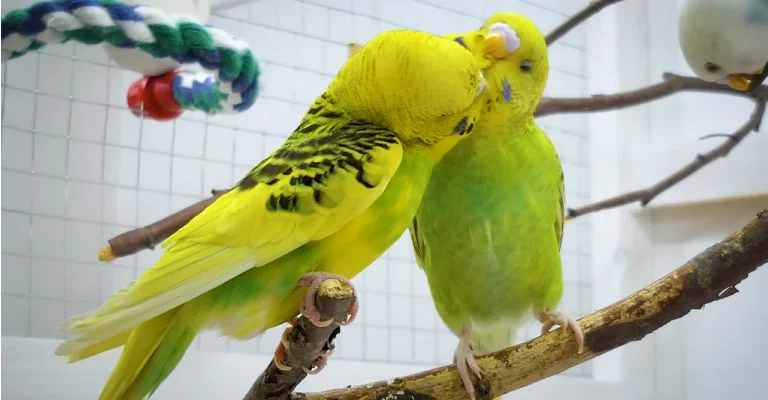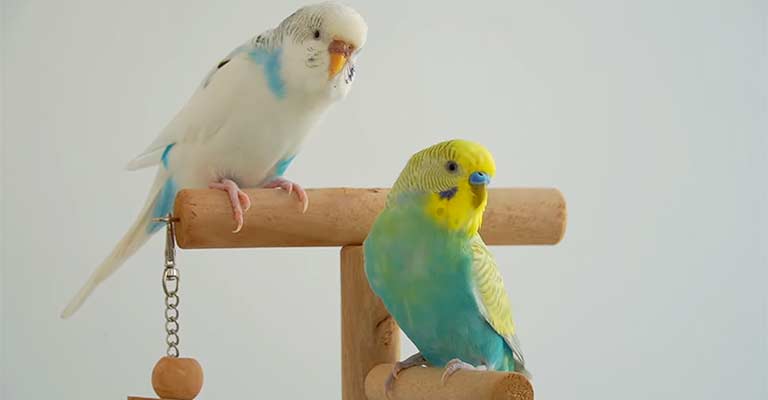Welcoming two budgies into your home can be a joyous decision, bringing double the charm and companionship. The prospect of witnessing these social birds interact and share their vibrant personalities is undeniably appealing.
However, the decision to have two budgies comes with its set of considerations. Understanding pros and cons of having two budgies is crucial for providing optimal care and ensuring the well-being of these intelligent feathered friends.
From the joy of shared chirps to the challenges of potential territorial disputes, exploring the dynamics of having two budgies sheds light on the intricate balance required for a harmonious multi-budgie household.

The Pros of Owning Two Budgies
Owning two budgies can be a delightful experience with several benefits:
Here are the pros of having two budgies:
Companionship and Social Interaction
One of the primary advantages of having two budgies is the companionship they provide to each other. Budgies are highly social birds, and having a feathered friend allows them to engage in natural flock behaviors.
They can communicate, play, and preen each other, contributing to their mental and emotional well-being.
Reduced Loneliness and Boredom
Budgies are intelligent and thrive on stimulation. With a companion, they are less likely to experience loneliness or boredom. Interacting with another budgie provides entertainment and mental engagement, reducing the risk of behavioral issues that can arise from lack of stimulation.
Mimicking and Learning From Each Other
Budgies are excellent mimickers, and having two allows them to learn from each other. They may pick up new sounds, words, or behaviors by observing their companion, enriching their repertoire of vocalizations and activities.
Emotional Support and Comfort
In times of stress or changes in the environment, having a companion offers emotional support. Budgies can find comfort in the presence of their cage mate, helping them navigate unfamiliar situations with increased confidence.
Health Benefits Through Mutual Grooming
Mutual grooming is a natural behavior in budgies that helps maintain their plumage and strengthen social bonds. Having two budgies allows them to engage in this reciprocal grooming, promoting not only a healthy coat but also strengthening their social connection.
Security and Safety
Budgies feel more secure in the presence of a companion. The presence of another bird can provide a sense of safety, especially in new or potentially intimidating situations. This security contributes to an overall sense of well-being.
Prevention of Behavioral Issues
Budgies kept alone may develop behavioral problems, such as excessive screaming or feather plucking, due to stress or boredom. Having a companion helps prevent these issues by providing mental stimulation, social interaction, and a more enriched environment.
In summary, having two budgies offers numerous benefits, fostering a healthier and happier environment for these sociable birds.
The companionship, shared activities, and emotional support they provide each other contribute significantly to their overall well-being.
The Cons of Owning Two Budgies

Owning two budgies, while rewarding, also comes with certain challenges:
Here are some cons of having two budgies:
Potential for Bonding Issues
While having two budgies can foster companionship, there is a risk of the birds forming a stronger bond with each other than with their human caretaker.
This can make it more challenging for the owner to establish a close relationship with each budgie individually, as they may prioritize interactions with their feathered companion over human interaction.
Increased Noise Level
Budgies are known for their vocalizations, and when you have two or more, the noise level can significantly increase.
The chatter, squabbling, and vocalizations between the budgies may become louder and more constant, which can be a concern if you live in an apartment or close quarters.
Aggression and Dominance Issues
Introducing a second budgie can lead to territorial disputes and dominance struggles. While many budgies get along well, there’s a risk that one may become dominant, leading to potential aggression or bullying. This dynamic can result in stress and discomfort for the subordinate bird.
Health Concerns Spread
In a shared environment, diseases or health issues can spread more easily between budgies. If one bird becomes sick, the close proximity increases the risk of transmission to the other.
Regular veterinary check-ups and quarantine procedures for new birds can help mitigate this risk.
Space and Cage Size Requirements
Having two budgies means you need a larger cage and more space to accommodate their social needs. A cramped living space can lead to territorial disputes and stress.
Ensuring an adequately sized cage and providing enough space for both birds to move around comfortably is essential.
Double the Cleanup
More budgies mean more mess. Cleaning duties, including changing cage lining, providing fresh food and water, and managing scattered seed hulls, can become more time-consuming.
Owners need to be prepared for the increased maintenance that comes with multiple birds.
Potential for Codependency
While companionship is beneficial, there’s a risk of the birds becoming overly dependent on each other. This can result in behavioral issues if one bird becomes stressed when separated from its companion.
Encouraging individual playtime and interaction with the owner is crucial to prevent codependency.
While many people successfully keep multiple budgies, it’s essential to be aware of the potential challenges and take steps to address them proactively.
Providing adequate space, monitoring behavior, and ensuring individual attention can contribute to a harmonious multi-budgie household.
How Do I Make A Bond Of My Two Budgies?

Let’s discuss how you make a bond between your two budgies:
Gradual Introduction
Start by introducing the two budgies gradually. Place their cages near each other so they can observe and vocalize without direct contact.
This allows them to become familiar with each other’s presence without feeling threatened. Over time, move the cages closer until they are comfortable being side by side.
Shared Playtime
Provide a neutral space outside of the cages for shared playtime. This area should be new to both budgies to avoid territorial issues. Supervise their interactions, allowing them to explore, play, and get acquainted.
Positive experiences during shared playtime help build a foundation for a positive bond.
Mealtime Harmony
Share mealtimes by placing their food bowls close to each other. This encourages a sense of camaraderie as they eat together. Ensure there are enough food and water bowls to prevent competition and monitor for any signs of aggression or discomfort during feeding.
Mutual Activities
Introduce toys and activities that both budgies can enjoy together. This can include swings, mirrors, or interactive toys. Shared activities help them associate positive experiences with each other, fostering a sense of companionship.
Treats and Positive Reinforcement
Use treats as a form of positive reinforcement during interactions. Reward both budgies when they display calm and non-aggressive behavior around each other.
This creates positive associations and encourages them to view each other as a source of enjoyment rather than competition.
Respect Individual Space
While encouraging interaction, also respect each budgie’s need for individual space. Avoid forcing interactions or putting them in situations where they feel threatened. This allows them to build trust at their own pace and minimizes stress.
Observation and Patience
Spend time observing their interactions and understanding their body language. Patience is crucial as budgies may take time to form a strong bond. Be attentive to any signs of stress, aggression, or discomfort, and adjust the introduction process accordingly.
Creating a bond between two budgies requires a gradual and positive approach. Patience, careful observation, and creating shared positive experiences are key elements in fostering a strong and harmonious relationship between your feathered companions.
FAQs
A cage size of 24x24x24 inches is suitable for two budgies. However, it’s recommended to opt for a larger cage to provide enough space for them to move around comfortably.
No, it is not necessary, but it is recommended to have two budgies of the same gender to avoid breeding.
Common health problems in budgies include respiratory infections, egg-laying problems, feather plucking, and malnutrition.
Yes, budgies can live alone, but it’s recommended to provide them with a companion for socialization and entertainment.
Budgies should be bathed regularly, about once or twice a week.
It’s recommended to dedicate at least 30 minutes of one-on-one time with your budgies daily to bond and build trust.
Conclusion
In the dichotomy of having two budgies, the scales tip between the joys of shared camaraderie and the challenges of potential conflicts. The companionship they offer each other can be heartwarming, reducing loneliness and providing mental stimulation.
However, the increased noise level and the potential for bonding issues require thoughtful consideration. Balancing these aspects demands dedication, from providing an adequately sized cage to monitoring their interactions.
Ultimately, the decision to have two budgies is a personal one, shaped by an awareness of the responsibilities and rewards that come with doubling the avian delight in your home.